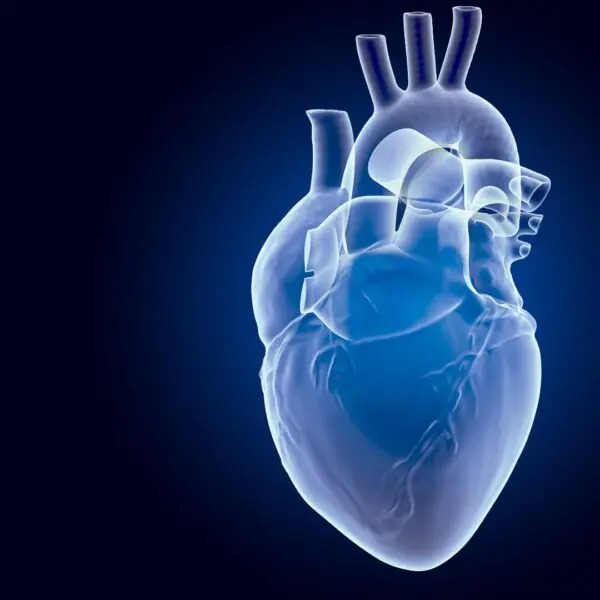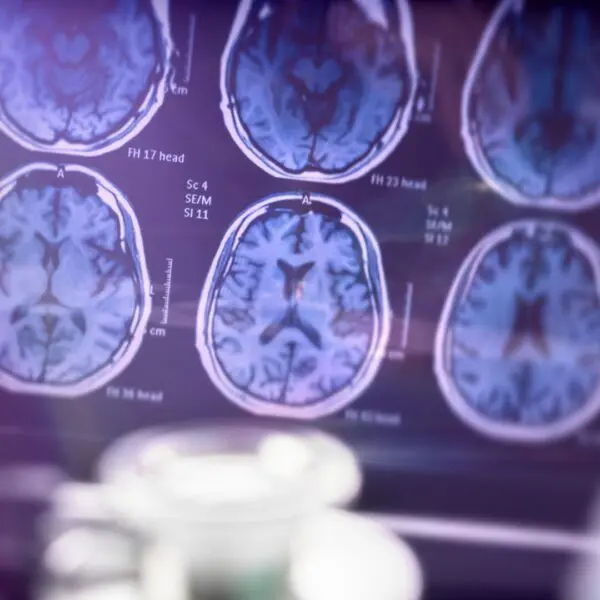
There are four main longevity pathways identified in organisms including humans: 1. AMP-activated protein kinase (AMPK) pathway 2. mTOR Pathway 3. Sirtuin Pathway 4. Nuclear factor-kappa B (NF-kB) pathway. In this blog we would like first like to address the AMPK pathway. AMPK is an important aspect of the new field of bioenergetics.
Although the above picture looks to be modern art it is actually a picture of molecular structure of AMPK which is an enzyme. An enzyme is a protein that performs chemical reactions. AMPK’s full name is 5’-AMP-activated protein Kinase. A kinase is an enzyme that transfers a phosphate ion to another protein, a reaction known as phosphorylation that acts as a biomolecular “on/off switch”, turning the activity of that protein either on or off. We should think of enzymes as traffic lights. They can slow, speed up, or stop metabolic processes. A metabolic pathway is a series of chemical reactions in a cell that build and breakdown molecules for cellular processes. Anabolic pathways synthesize molecules and require energy. Catabolic pathways break down molecules and produce energy. AMPK is more of a catabolic pathway. The following illustration shows this well:

AMPK IS CONSIDERED A CATABOLIC PATHWAY
Typically, most diseases in the body result when there are malfunctions related to a pathway. This is the reason that in order to truly address Anti-Aging one must address these four pillars of the pathways of aging. Malfunction of these pathways are what is called the upstream causes of aging. The AMPK pathway is one of the major players that can have a dramatic effect in slowing down aging. What affects the AMPK pathway will have many effects downstream from it.
WHAT EXACTLY IS AMPK?

The above diagram represents the cycle of how the body produces ATP from the assistance of AMPK. The metabolic protein AMPK has been described as a kind of magic bullet for health. Studies in animal models have shown that compounds that activate the protein have health-promoting effects to reverse diabetes, improve cardiovascular health, treat mitochondrial disease and even extend life span. AMP-activated protein kinase, or AMPK, is known as a master regulator of metabolism. It is a fuel sensing enzyme found in all mammalian cells. The science of bioenergetics is producing paradigm-shifting discoveries, including the role of AMPK in regulating the ways our bodies use and transform energy. Cells activate AMPK when they are running low on energy, and AMPK is activated in tissues throughout the body following exercise or during calorie restriction. In response, AMPK alters the activity of many other genes and proteins, helping keep cells alive and functioning even when they’re running low on fuel. AMPK is the “switch” that is the link between metabolic disease, inflammation, and longevity. This “switch” tells our cells when to store and generate energy-containing molecules such as fat, and when to “hunker down” and use existing energy stores. For our survival, AMPK needs to maintain cellular homeostasis that requires efficient regulation of energy metabolism during rest and especially when under greater stress. AMPK controls energy metabolism in cells and helps to maintain an energetic balance by mobilizing the body’s fuel sources. AMPK gets activated by increased concentrations of AMP and ADP due to ATP depletion. AMP or adenosine monophosphate is a nucleotide that gets interconverted into ADP or ATP. This process helps to produce energy. AMPK uses AMP for maintaining homeostasis during high energy expenditure such as exercise. ADP or adenosine diphosphate is an organic compound found in cells that helps energy currents. ATP or adenosine triphosphate is an organic chemical that provides energy for all cellular processes, such as muscle contractions, nerve impulses, and chemical syntheses. It’s often called the energy currency of the cells. AMPK detects the number of ATP in cells and then regulates it when it gets too high or too low.
In different tissues throughout the body and at different time points in development, AMPK likely has varying effects.
Remember that ATP is intimately related to the mitochondria. AMPK is a kinase enzyme that transfers a phosphate ion to another protein. This is a reaction known as phosphorylation that acts as a biomolecular “on/off switch”, turning the of that protein either on or off. Many steps of phosphorylation occur between different proteins communicating to one another in a “cell-signaling cascade”. These signals take an input (such as a hormone, drug or exercise) and can induce any number of outcomes including cell growth, cell death, energy breakdown, energy storage or turning on specific genes for expression. Ultimately, cell signaling is required for all of the physiological processes that we perform as organisms and is key to how we adapt in training to become stronger, faster and fitter.
WHAT PROBLEMS ARISE WHEN AMPK PATHWAY IS NOT FUNCTIONING PROPERLY
The following illustration shows the various avenues of damage caused by the malfunction of the AMPK pathway. These malfunctions involve three of the cardinal areas where problems arise. Metabolic dysfunction is probably the biggest while loss of proteostasis (protein homeostasis) and the loss of genetic instability are not far behind:

We can see that AMPK problems lead to multiple problems and as we get older they seem to be compounded. Also important are the effects AMPK may have on the other pathways of aging. Like many things in life as we age the pathway becomes less active you will notice that AMPK effects all the other major pathways of aging.

We can see essentially most of the major pathways the are directly affected by the AMPK pathway. These include NFkB, Sirt1, and mTOR. In more practical terms the next illustration shows the “deadly effects” of an AMPK deficit. These are all aspects of an unhealthy individual who is rapidly aging and is showing the aspects of “inflammaging”.

We can see very well the far-ranging effects that a deficiency of AMPK will have upon the body. In some way shape or form all of these problems lead to increasing inflammation in the body. This inflammation which is associated with aging is now called “Inflammaging”. It seems that if we can get a handle on AMPK and prevent it deficits, we might just get a better handle on aging. There are a number of methods that we can improve how our body deals with the AMPK pathway. The next section discusses this in greater detail. Remember AMPK deficiency is not just genetic in nature.
One other significant finding in the AMPK pathway is the effect AMPK has upon the health of our gut bacteria. Many medical problems arise when our gut bacteria is not in a healthy state. Accumulating studies have demonstrated that AMPK activation enhances paracellular junctions, nutrient transporters, autophagy and apoptosis, and suppresses inflammation and carcinogenesis in the intestine, indicating an essential role of AMPK in intestinal health. Gut health and the mitochondria are intimately related. The flowing diagram show how AMPK and gut health affect metabolism, inflammation, and oxidative stress. We are aware that a number of diabetes medicines target AMPK and ultimately have their effects on the gut bacteria. Metformin is one such medicine. Although it is mainly used for diabetic control Metformin is used by many non-diabetics for its anti-aging, anti-cancer, and potential performance enhancing properties due to its effects on the AMPK pathway.

We can extrapolate this further on athletic performance. There seems to be a crosstalk between the gut microbiota and mitochondria during Exercise. This can be seen in the following illustration. Ultimately we need to remember that we are only as healthy as our mitochondria.

What we see is that endurance performance is increased by the relationship between the gut, AMPK, and mitochondria functions. We can see that it is very important to maintain our gut bacteria in the best of condition. This is why probiotics are very important in maintaining the AMPK pathway. Remember that a healthy gut is a healthy and typically a happy patient.
WHAT ARE BEST WAYS TO CONTROL AMPK PATHWAY

There are a number of methods to control and stimulate the AMPK pathway. Some involve medications and supplements. Diet seems to play a large role in managing the AMPK pathway. That is rather evident in the above diagram.
Exercise, we now know, is one of the most powerful AMPK-activating strategies. Activated AMPK promotes all the processes we look for to maintain a youthful profile: rapid, efficient release of energy, with little energy storage as fat or new sugar molecules. Thus, activated AMPK keeps us lean and active, with a steady renewal of cellular components. AMPK activity fades with age. Just as importantly, when excessive calories are available, the result is accelerated tissue aging. You can boost AMPK activity through exercise and/or calorie restriction, but should also make use of natural supplements that support AMPK activity. Boosting AMPK activity will keep your tissues young and slow aging throughout your body. It is now clear that, when caloric intake remains much higher than needed to sustain energy expenditure AMPK activation is markedly decreased. With reduced AMPK activity, cells decrease their energy-releasing ATP-generating activities, and instead shift to energy-storing processes that generate new fat deposits and glucose molecules leading to premature aging and diseases.

The above picture shows Barberries which are the red berries from the Berberis vulgaris plant. These compounds contain the compound called Berberine. Berberine acts similar to the common diabetes medicine called metformin. Berberine seems to be a potent activator of the AMPK pathway. It has minimal side effects. Also as stated earlier, it is crucial to maintain the health of one’s gut bacteria. What else seems to affect AMPK pathway in a positive way? What other supplements also are beneficial when dealing with the AMPK pathway. These supplements include Resveratrol, Alpha Lipoic Acid, Gynostemma (a form of Ginseng), Curcumin and Quercetin. They all seem to act as potent stimulators of the AMPK pathway. The good news is that our clinic now has the ability to deliver Quercetin and Curcumin via an intravenous route. The bottom line is that we can now take AMPK stimulation to the next level.
Thanks,
JP














